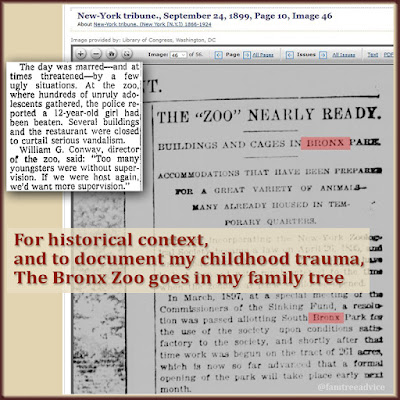Have you ever given someone genealogy advice, and not followed it yourself?
This is my 297th blog article in 2½ years. I publish twice a week. To keep up with that schedule, I spend time each day working on my family tree. Then I write about whatever I've been doing.
If I'm working to connect with a DNA match, I write about that. If I'm developing a system for naming and tracking my files, I write about that. If I discover a useful website, I write about that.
But with all the writing, I rarely get a chance to complete the projects I recommend for you. This is a recap of some of my favorite recommendations that I wish I had time to complete. Which ones appeal the most to you?
We all need to take another look at our earliest genealogy work and make improvements. I still have some unofficial sources I want to replace with better sources and images. I have some facts that came from the family tree of a distant relative. That's not good enough. I need to find a reliable source.
I liked this idea enough to write about it again in Trade Up to Better Family History Sources.
 |
| Imagine the look on your future descendant's face when she finds your collection of family history books. |
One of my biggest desires as a genealogist is to find the best way to share what I've found with my relatives. This article describes how to create a family tree book you can share. Imagine presenting a book to everyone at a family reunion.
I covered this idea again in 5 Steps to Writing Your Ancestor's Life Story, and the very popular article, How to Create a 'Book of Life' for Your Relatives.
I've been really good about following this advice. But my older documents need my attention. If you add facts to the properties of your digital documents (like census sheets, ship manifest, etc.), you'll never wonder where they came from. And you'll be able to get right back to their source.
 |
| Annotate your image the moment you get it. You'll never forget where you found it. |
Yes, we need to replace unofficial sources with official ones. But we also need sources for the modern-day facts we just know. For example, I was baptized in a church in the Bronx, New York. The only source for that fact is my baptismal certificate. I could scan and add it to my family tree. I could add my birth certificate, too. But if you're adding documents for anyone who's living, make the images private. They're mainly there for you.
One of the genealogy goals I set for 2019 (and completed) helped me close the book on some families. "Closing the book" means finding all the documents you're missing for a family. For example, think of your great uncle. Do you have every census record for him? Do you have all his immigration and naturalization papers? His birth, marriage and death records? What about documents for his children?
When you have all the documents, you can "close the book" on that family.
When I wrote about the funeral cards I'd collected for some relatives, my cousin texted me photos of a ton more. Funeral cards serve as evidence for death dates. And sometimes they can say more—or have a photo. I still need to clean up the images my cousin sent me and place those funeral cards in my family tree.
 |
| A "Book of Life" isn't meant for celebrities only. Make them for your family. |
I started dealing with my family photos, but I have a long way to go. They're stored in too many folders on my computer. That makes it hard to find the exact one I want. I've got to name and file them properly. Then I've got to double-check that I've scanned all the old photos my mother left with me when she moved. Finally, I have to make sure they get into my family tree.






![I get angry when my seat on an airplane is too cramped. My poor ancestors rode in the belly of one of these. I get angry when my seat on an airplane is too cramped. My poor ancestors rode in the belly of one of these. ... Ancestry.com. New York Port, Ship Images, 1851-1891 [database online]. Provo, Utah: MyFamily.com, Inc., 2004. Original data: Ship images obtained from and reproduced courtesy of Mystic Seaport.](https://blogger.googleusercontent.com/img/b/R29vZ2xl/AVvXsEjrXM3ChMWg4WfEZpcqoi05bTQd5lSKLcseicXO345jpmMZtVS31qAIUhNTbnAtbVVq9dklCiSuDbwH3L1pBupNXfJikq8kpIdxw71_KKUd_7g0solx2WMTs8j28SLvIfNGzku04s_40Eg/w400-h301/073019-ship.jpg)


